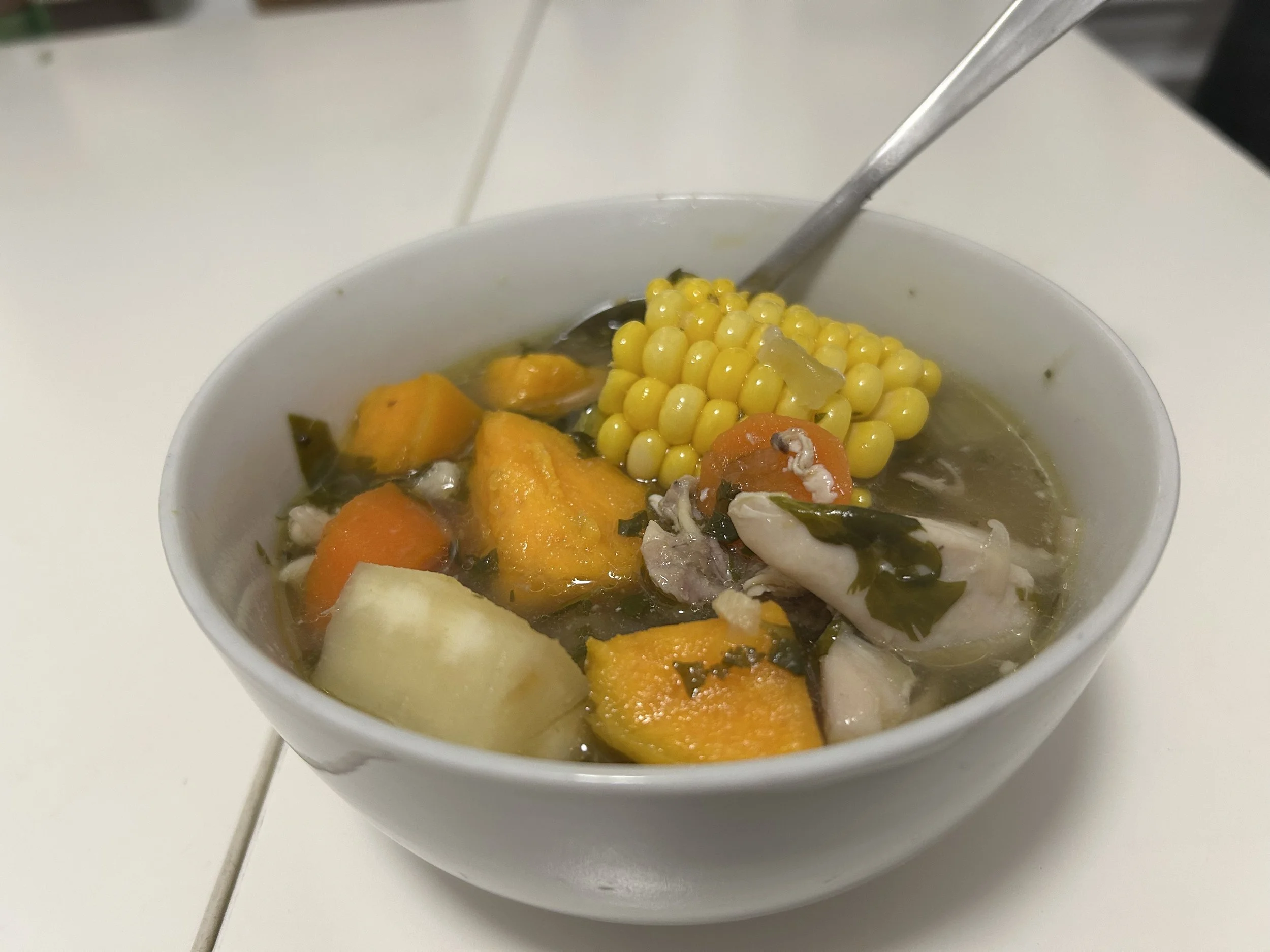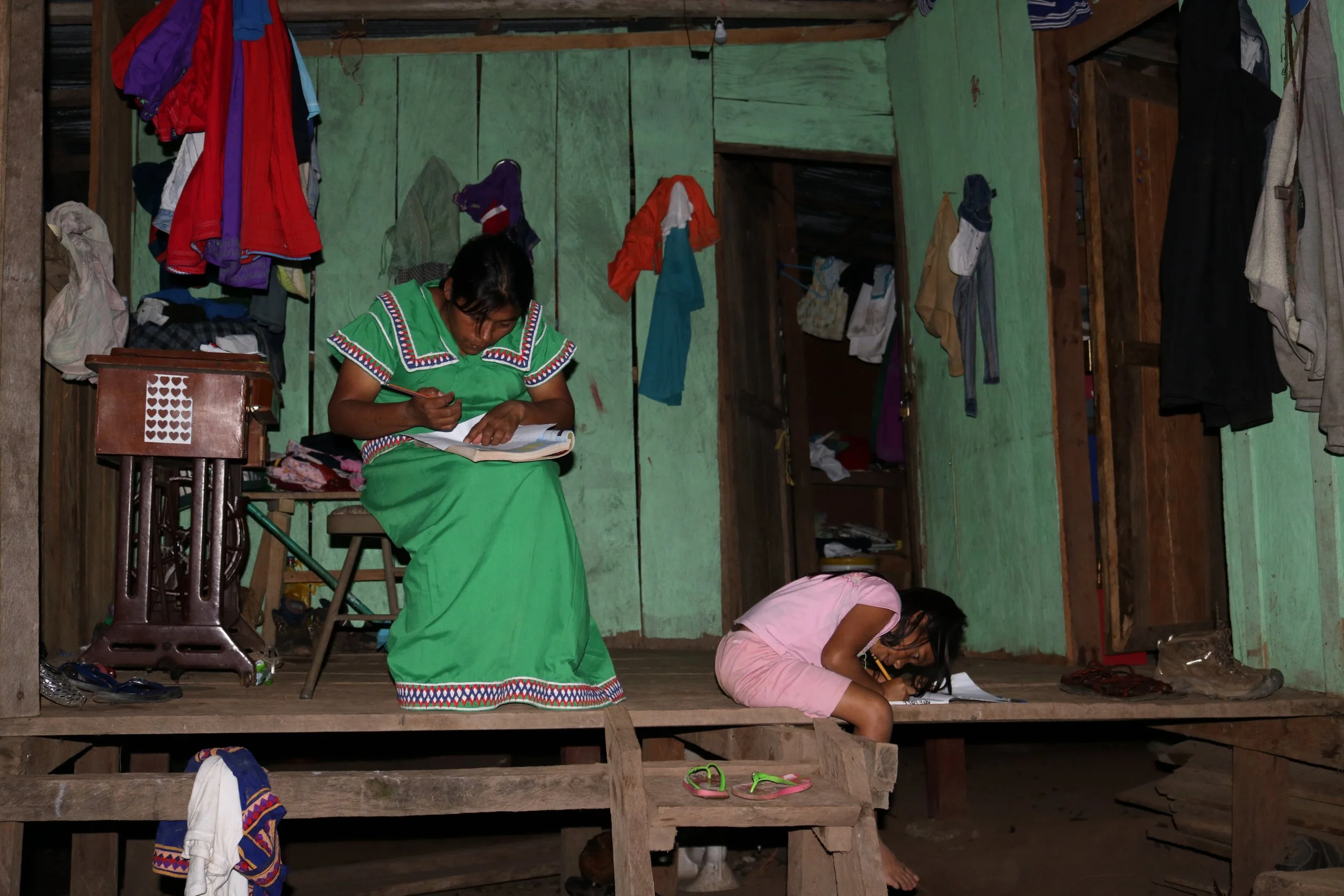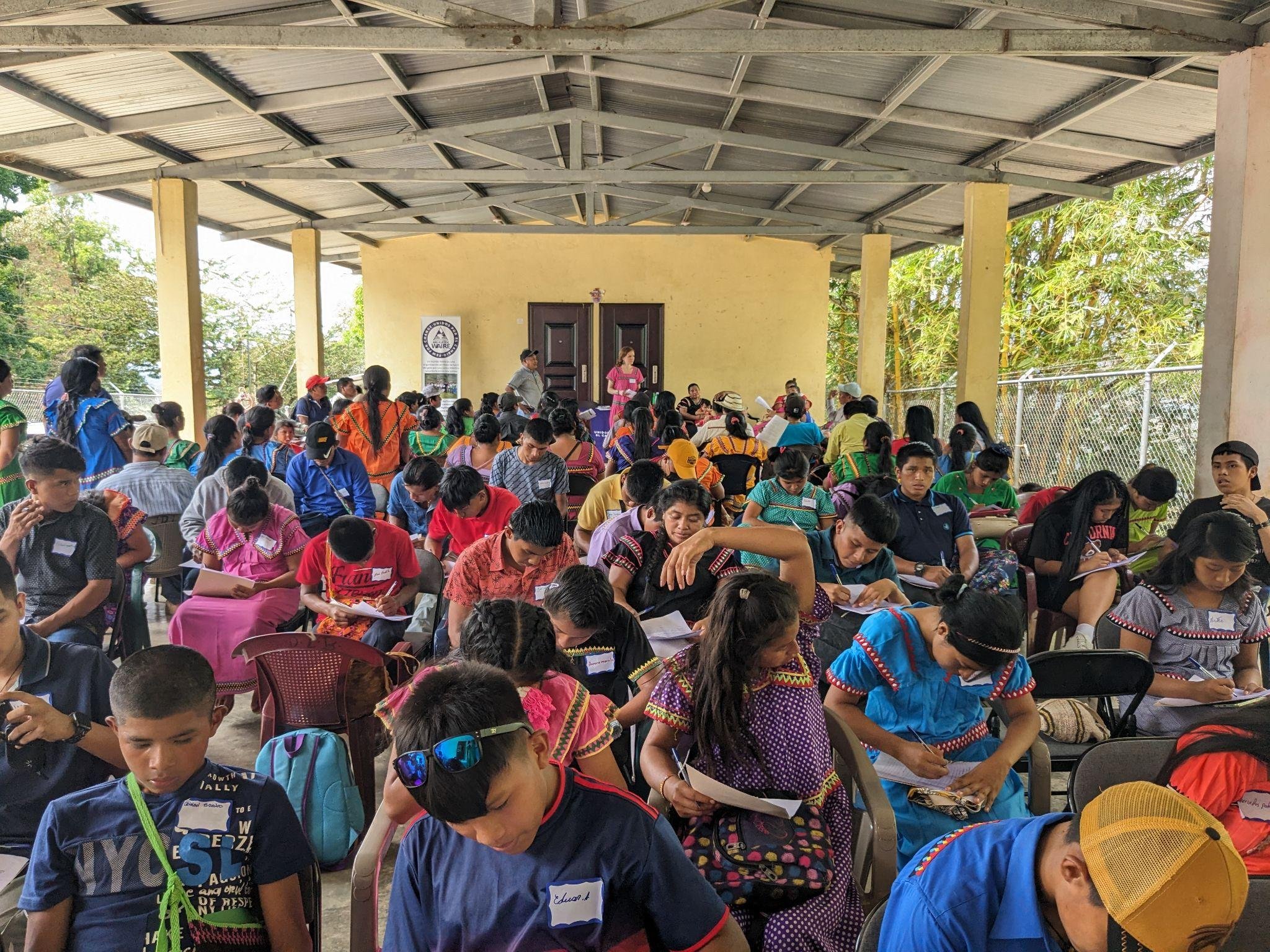This is the second post in a two-part series by Few for Change Communications Fellow Morgan Oestereich. Part I introduces the Comarcal system of indigenous land rights in Panama, as well as the indigenous groups living in western Panama. If you have not read Part 1, we encourage you to do so first. Now, we continue with the indigenous groups of eastern Panama: the Guna, Emberá, and Wounaan. Be sure to read until the end, where you can find resources to support local and Panamanian indigenous communities.
Guna
The Guna occupy three of Panama’s five Comarcas, containing 66 communities. The largest of these Comarcas is Guna Yala, literally meaning “Guna Land,” which contains 51 communities. The majority of the over 50,000 Guna live here, mainly on island communities in the Caribbean where lobstering, fishing, and tourism drive the economy. There are also large Guna populations in Panama City and Colón, a major city on the Caribbean coast of Panama.
Guna territory was once part of Colombia, and the Guna were granted a Colombian Comarca as early as 1870. However, when Panama was formed from Gran Colombia in 1903, the Guna lost this recognition, and today only a few small Guna settlements remain in present-day Colombia. Rising tensions and violence against the Guna eventually led to the Guna Revolution of 1925, during which the Guna declared independence from Panama. Following a peace treaty with Panama, the Guna were granted their own territory in 1938, and the Comarca Guna Yala--Panama’s first Comarca--was finalized in 1953.
The Guna are known internationally for their textile art form called molas, which are brightly colored textiles traditionally used to create the women’s traditional dress, but now are also sold as purses, hats, and in other forms to generate tourism revenue. Guna society is also matriarchal; grooms take the family name of their wife, and young women have ceremonies celebrating their passage into adulthood.
Guna Yala faces many environmental threats. Sea level rise threatens many Guna communities which exist on low-elevation islands in the Caribbean. The region lacks waste disposal infrastructure due to the Comarca’s rapidly growing population and the difficulty of building on these small, low-lying islands. This means that trash and sewage is often dumped directly into the sea, affecting the health of the reefs which supply fish and lobster as food and income. Similarly to other indigenous regions in Panama, many Guna are forced to leave the Comarca to find better educational and job opportunities[1,2].
Guna women alongside the culture’s famous mola textiles.
Emberá
The Emberá live in both Panama and Colombia, with a combined population of about 83,000 people. About 33,000 live in Panama, many of whom live in the Comarca Emberá-Wounaan.
The Emberá move from modern-day Colombia to Panama was prompted by Spanish colonizers who forced them west into Guna territory. Ever since, the Emberá have lived in the densely forested region known as the Darién, designated a Comarca in 1983. River systems within the Darién are integral to Emberá culture, and language variations within the ethnic group correspond with riverine geography. Historically, the Emberá lived in small communities along these rivers, however, missionaries in the 1960s encouraged the rapid formation of towns and urban centers. The importance of rivers is shown even in the culture’s marriage traditions, as historically men had to demonstrate their proficiency in the construction of dugout canoes to be ready for marriage[3,4].
The inundation of cattle ranchers and non-indigenous migration into the Darién has caused immense amounts of logging and deforestation. The Emberá also are known to practice female genital circumcision, with only 10% of the community having discontinued the practice. However, leaders within the Emberá are hoping to have complete discontinuation of FGC by 2030, after an infant girl died from the practice in 2007 and the taboo practice was brought into the spotlight[5].
Wounaan
Approximately 23,000 Wounaan live between Panama (approx. 8,200) and Colombia (approx.14,800). Culturally, the Wounaan are similar to the Emberá, however, they speak maach meu, a language entirely distinct from those spoken by Emberá people. Living in the same region with similar customs, the Wounaan face similar conflicts with encroaching ranchers as the Emberá. The Wounaan are known for their ancestral skills of weaving water-tight baskets and crafting elaborate canoes. Traditionally, both men and women take part in different elements of hunting, agriculture, and craftsmanship[4,6].
Emberá-Wounaan dancers.
Panama’s colonial history still impacts indigenous lives today.
Indigenous Panamanians continue to face the highest poverty rates and lowest educational achievement rates in the entire country. Neo-colonialism is present through oppressive cattle ranch expansion and destructive dam construction on native lands. While Comarcas grant certain populations autonomous rule and representation in Panama’s federal government, systemic discrimination continues to place Panama’s indigenous communities at a disadvantage. For example, indigenous Panamanians living within Comarcas have a life expectancy that is 11 years less than the overall population[7]. Additionally, poor educational funding has been correlated with higher poverty levels in Comarcas[8].
You can be a part of the solution. Interrogate your own biases by considering how you think about indigenous cultures and people. Uplift indigenous voices. Support organizations like Few for Change, and other groups dedicated to supporting indigenous people. With guidance from local cultural organizations, learn about indigenous communities whose land you currently occupy. Remember that Panama, along with the U.S., Canada, and other Pan-American countries, were founded on indigenous genocide. Know that you live on stolen land.
There are many active indigenous initiatives to support and share.
There are a myriad of organizations in Panama supporting indigenous groups. Organizations Supporting Indigenous People and Communities in Central America (ACICAFOC) is a broad-scale group of organizations that work to increase the responsible use of natural resources and the socioeconomic development of indigenous peoples. Recently, their Integrated Management of Natural Resources Program hosted its first virtual workshop, bringing together 30 indigenous communities from six Central American countries, including Panama. They discussed intercultural coexistence, COVID-19, youth and women involvement, and their ongoing sustainability efforts, such as the installation of solar panels, rainwater harvesting, and sustainable forestry in indigenous regions.
The National Coordination of Indigenous Peoples of Panama (COONAPIP) works to unite indigenous groups to promote the defense of indigenous lands and natural resources. COONAPIP has been working to provide COVID-19 information and guidelines in the languages of five of Panama’s indigenous groups: Guna, Ngäbe, Emberá, Wounaan, and Buglé. Due to geographical COVID restrictions, Naso and Bri Bri representatives were unable to participate, however, these groups are otherwise represented in COONAPIP.
The Center for Environmental and Human Development (CENDAH) plans and consults on projects in protected areas and education surrounding conservation in Guna Yala. In alliance with the Guna People's Cultural Heritage Institute (IPCPG) of Onmaggeddummad Namaggaled (the General Congress of Guna Culture) and local communities, CENDAH has been providing semillas de apoyo (seeds of support) to farmers in the Comarca. This has especially been important during the COVID-19 pandemic, as farmers grow medicinal plants used by the community to slow the spread of the disease.
A CONAMUIP gathering.
The National Coordination of Indigenous Women of Panama (CONAMUIP) works to strengthen the identity and leadership of indigenous Panamanian women, as well as supporting their families and promoting human rights. On October 12, 2020, CONAMUIP safely gathered in Panama City to protest Columbus Day. There, indigenous women and youth activists peacefully protested the celebration of the holiday. CONAMUIP has been holding such demonstrations annually for decades, aiming to spread awareness about the injustice and discrimination that Panama’s indigenous peoples and land face and have faced for centuries.
MarAlliance has worked within indigenous communities in Panama to support the health of marine ecosystems. In Guna Yala, MarAlliance has worked alongside Guna fishermen to combat invasive lionfish, monitor their small-scale fisheries, monitor the populations of other species in the region.
The Guna Yala Research and Development Institute (IIDKY) supports the protection of land, culture, and the economy in Guna Yala. IIDKY has assisted in the creation of a sustainable coconut oil company within Guna Yala, which would provide 30% of its profits to improving education, youth leadership programs, and zero-waste programs throughout the Comarca.
These organizations are just a small insight into the work that thousands of indigenous Panamanians are doing to support their communities.
This blog post serves not only to inform Few for Change supporters of Panama’s other indigenous communities, but as a reminder that indigenous cultures across the globe continue to thrive, adapt, and advocate for better futures. These seven diverse groups exist in an area smaller than the state of South Carolina9. There is likely an incredibly rich history, mythology, and culture of the indigenous groups that exist or existed where you live today! We encourage you to visit https://native-land.ca, if you haven’t before, to learn more about indigenous land near you.
Sources:
[1] https://www.gunayala.org.pa
[2] https://en.wikipedia.org/wiki/Guna_people
[3] https://en.wikipedia.org/wiki/Emberá_people
[4] https://www.ecured.cu/Emberá-Wounaan
[5]https://web.archive.org/web/20150714145347/https://www.reuters.com/article/2015/02/06/us-colombia-girls-fgm-idUSKBN0LA2FX20150206
[6] https://www.onic.org.co/pueblos/1155-waunana
[7] https://www.worldbank.org/en/country/panama/overview
[8] https://www.imf.org/external/pubs/ft/scr/2016/cr16338.pdf
[9] http://bibliohistorico.juridicas.unam.mx/libros/8/3640/11.pdf
Images:
[1] https://misskingcooking.files.wordpress.com/2013/04/kuna-woman-mujer-molas-san-blas-panama.jpg
[2] https://imagenes.laestrella.com.pa/files/image_990_491/uploads/2019/09/26/5d8c7b99a19b7.jpeg
[3] https://www.facebook.com/pg/Coordinadora-Nacional-de-Mujeres-Ind%C3%ADgenas-de-Panam%C3%A1-CONAMUIP-127159760719976/community/













